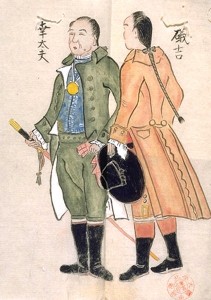
Story Highlights
- Historical event:
- 28 May 1828
- The Japanese man named Daikokuya Kōdayū experienced an incredible adventure in the Russian Empire around the time of the French Revolution, traveling all the way to the palace of Empress Catherine the Great. In the imperial palace at St. Petersburg, he had the honor to personally meet with the Empress on several occasions.
This day in 1828 marked the death of the interesting Japanese man named Daikokuya Kōdayū, who experienced an incredible adventure in the Russian Empire around the time of the French Revolution.
By profession Daikokuya Kōdayū was a seaman, the captain of the Japanese ship Shinsho-maru. During one voyage in 1782, he and his crew got caught in a major storm somewhere between today’s Tokyo and Osaka. Due to the storm, the ship was thrown far off course and floated on the open sea for seven months. After these seven months, they reached the island Amchitka near Alaska and landed there.
Alaska was at that time a Russian territory, so the Japanese on the island Amchitka met with the Russians and with the local population – the Aleut people. Just to mention, the island Amchitka became famous in the late 1960s when the Americans conducted powerful underground nuclear testing there (the United States bought Alaska from Russia in the 19th century). The core of the famous Greenpeace movement was formed precisely as a reaction to these tests.

The Japanese castaways on Amchitka, together with the Russians, built a ship with sails made of animal skins. Aboard this improvised vessel, they set sail towards distant Kamchatka (the Russian peninsula in the far east of Asia), it was an almost incredible endeavor.
At Kamchatka, the Japanese met French diplomat and scientist Barthélemy de Lesseps. He was the uncle of the famous Ferdinand de Lesseps (the builder of the Suez Canal). Lesseps was there as a part of a research expedition. From Kamchatka, the Japanese went over Okhotsk, Yakutsk, and Irkutsk, finally reaching the Russian imperial capital St. Petersburg, where Empress Catherine the Great ruled at that time. Of course, this means that the Japanese traveled across the entire Siberia and crossed the Urals.
In the imperial palace at St. Petersburg, the Japanese captain had the honor to personally meet with the Empress on several occasions. He asked for them to be allowed to return to Japan, which was finally approved. This was precisely at the time of the French Revolution. Daikokuya Kōdayū managed to return to his native Japan, along with another countryman (the rest of the original crew was partly killed and partly decided to stay at various places along the way). Daikokuya Kōdayū lived for approximately thirty more years, in Japan.




